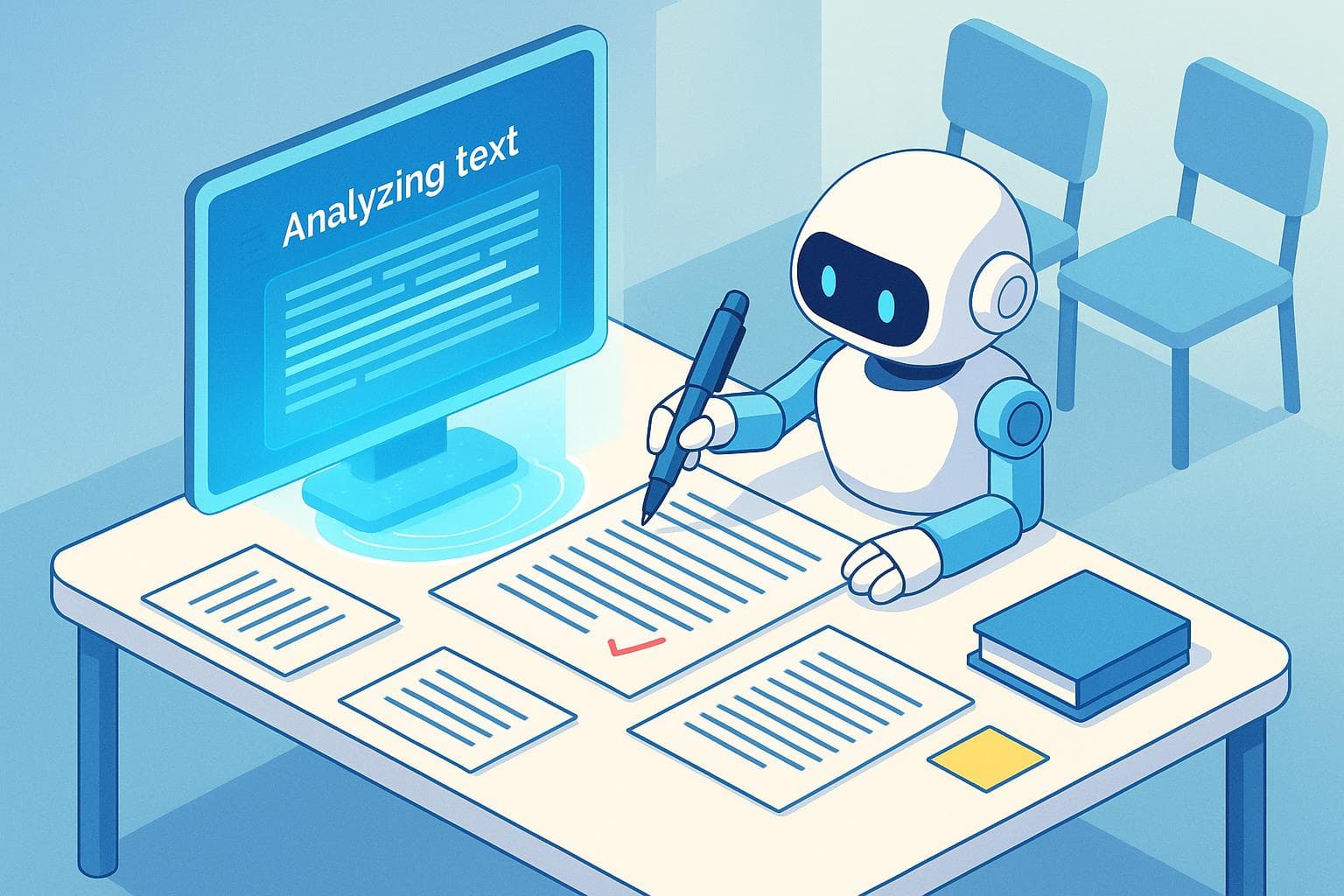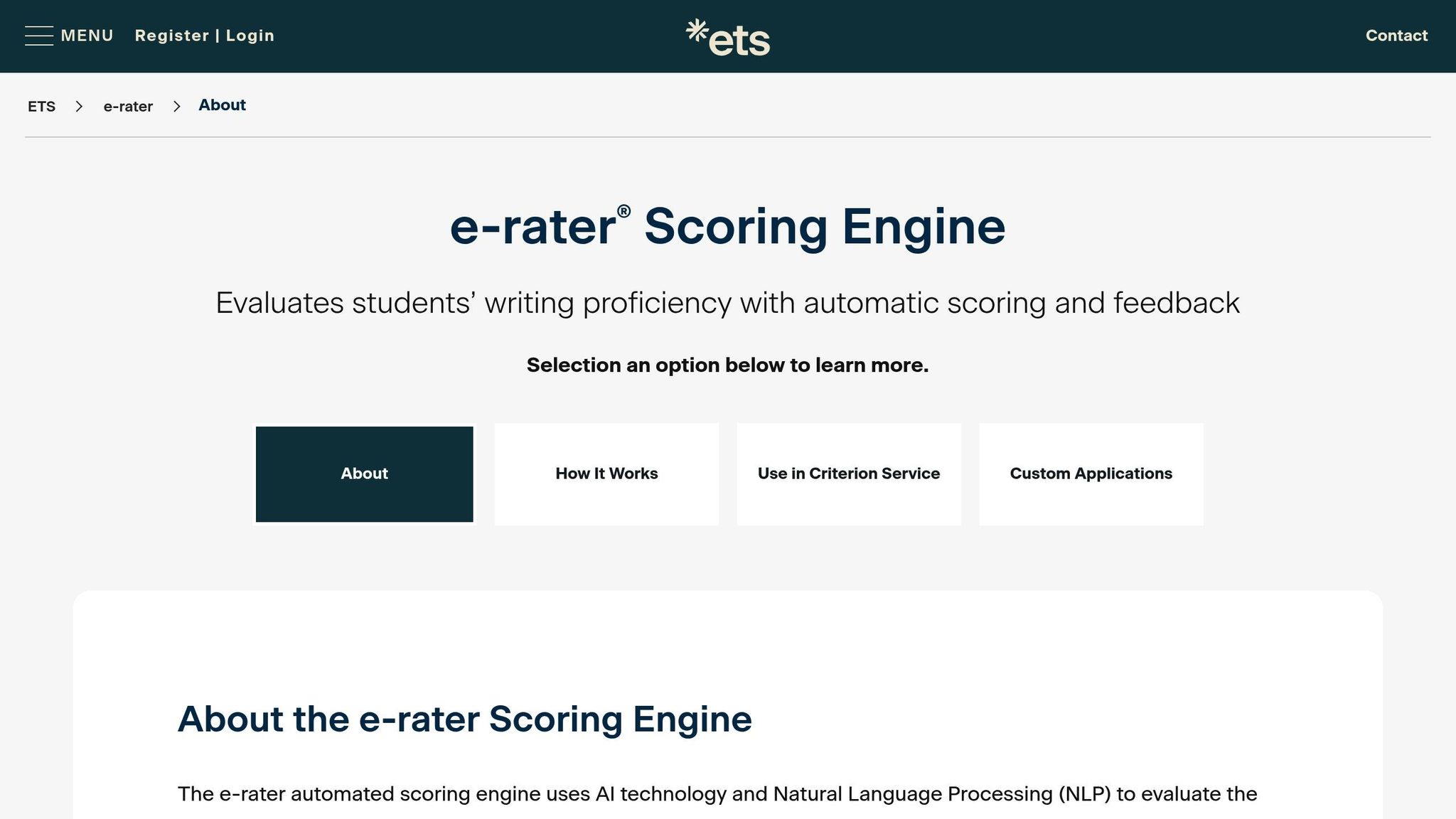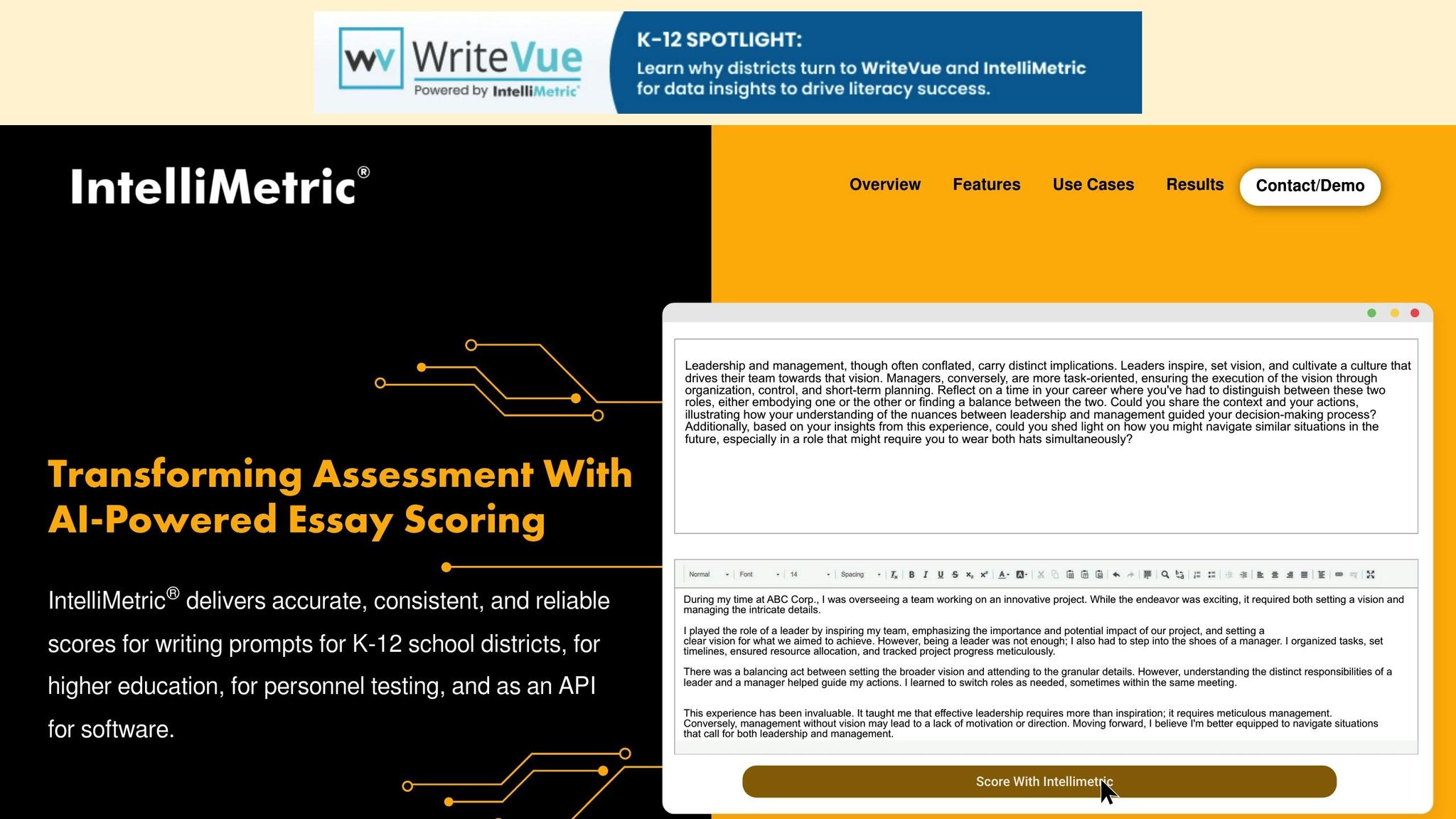
How NLP Powers Automated Essay Scoring
Automated Essay Scoring (AES) systems use Natural Language Processing (NLP) to evaluate essays quickly and consistently. These tools analyze grammar, vocabulary, structure, and flow to provide accurate feedback. Here's what you need to know:
- Fast and Consistent: AES systems grade essays instantly and apply uniform criteria across submissions.
- Core Technology: NLP techniques like tokenization, grammar checks, and transformer models (e.g., BERT) drive the scoring process.
- Key Benefits: Instant feedback, scalability for large workloads, and alignment with grading rubrics.
- Popular Platforms: ETS e-Rater, IntelliMetric, and QuizCat AI integrate AES for grading and study support.
- Challenges: AES struggles with creative writing, nuanced arguments, and fairness issues due to biases in training data.
While AES systems improve efficiency in education, ongoing research aims to address limitations like bias and scoring consistency.
Automated Essay Scoring with AI: A Brief Introduction
Core NLP Technologies in Essay Scoring
Automated Essay Scoring (AES) systems rely on sophisticated Natural Language Processing (NLP) techniques and diverse analytical methods to evaluate essays with accuracy comparable to human graders.
Text Analysis Methods
The process begins with foundational text processing techniques like tokenization, stemming, and lemmatization, which help standardize and segment the text. From there, syntactic analysis - such as part-of-speech tagging and parsing - examines sentence structure and grammatical accuracy. These systems focus on:
- Grammar structure: Analyzing sentence construction for correctness.
- Vocabulary usage: Evaluating word choice and complexity.
- Coherence: Checking the logical flow and connection of ideas.
- Writing mechanics: Detecting errors in spelling, punctuation, and formatting.
These initial steps lay the groundwork for applying more advanced machine learning techniques.
Machine Learning in Scoring
Once the text is analyzed, machine learning models come into play to refine the evaluation. AES systems often utilize transformer-based models like BERT and GPT, which excel at understanding context and identifying intricate relationships between ideas.
Here’s how these models perform:
| Model Feature | Performance Metric | Score |
|---|---|---|
| Accuracy Rate | Overall Scoring | 93% |
| Recall Rate | Error Detection | 91% |
| F1 Score | Combined Performance | 88% |
These metrics highlight the system's ability to balance precision, recall, and overall effectiveness in essay evaluation.
Scoring Based on Rubrics
AES systems don't just rely on algorithms - they align with structured grading rubrics to meet educational standards. These rubrics break down criteria like content quality, organization, and writing style into measurable features. The system evaluates essays by:
- Comparing content against model answers.
- Analyzing organizational structure and logical flow.
- Assessing the coherence of arguments.
- Measuring technical accuracy in grammar and mechanics.
Current AES Platforms
ETS e-Rater System

The ETS e-Rater is a prominent AES platform often used alongside human graders for exams like the GRE and TOEFL. It evaluates essays based on grammar, mechanics, style, organization, and development. By leveraging natural language processing (NLP), the system examines:
- Syntactic variety
- Discourse elements
- Topic relevance
- Vocabulary sophistication
Other automated essay scoring systems use different approaches to assess writing quality.
IntelliMetric and PEG Systems

Two other notable platforms include PEG and IntelliMetric. PEG focuses on measurable features like essay length, word complexity, and punctuation. On the other hand, IntelliMetric takes a broader approach, analyzing semantic, syntactic, and discourse features to provide a more comprehensive evaluation.
Study Tool Integration
AES technology is increasingly being integrated into learning platforms, revolutionizing how students study. A great example is QuizCat AI, which transforms study materials into interactive tools like quizzes and flashcards. This platform showcases how AES can go beyond grading to enhance the learning process itself. With a user base exceeding 400,000 active students, QuizCat AI highlights the practical benefits of AES in everyday education.
Key advantages of such integrations include:
- Personalized learning paths tailored to individual needs
- Multi-modal learning options like quizzes, flashcards, and audio lessons
- Streamlined study routines through AI-powered content creation
"A lifesaver during finals. Uploaded my notes, hit 'create,' and BOOM - quizzes and flashcards ready to go. It's like having a personal tutor 24/7." – Jake Harrison
These advancements illustrate how AES is shaping the future of educational technology, making learning more efficient and accessible.
Current Limitations of AES
Technical Constraints
Even sophisticated models like BERT face challenges when it comes to interpreting creative language elements such as metaphors, irony, or nuanced arguments. AES systems also struggle with longer essays because they tend to evaluate sentences individually rather than considering how ideas connect across paragraphs. These technical limitations highlight broader ethical concerns tied to automated scoring.
Ethics and Fairness
AES systems often reflect the biases present in their training data, which can disadvantage certain groups of students. For example, patterns in scoring reveal systemic issues:
| Student Group | Scoring Impact |
|---|---|
| Non-native English speakers | Content undervalued despite valid expression |
| Students with learning disabilities | Penalized for alternative writing approaches |
| Cultural minorities | Misinterpretation of cultural writing styles |
The "black box" nature of commercial AES systems adds another layer of concern, as the reasoning behind specific scores is often unclear.
Scoring Consistency
While AES systems can achieve a correlation of 0.70–0.85 with human scores on standardized essays, their performance drops significantly when evaluating more complex or creative writing. Consistency in scoring remains a major hurdle, with reliability varying based on essay length, topic, and writing style.
Another area where AES systems fall short is in evaluating citation quality and how evidence is integrated into academic writing. While they can identify citation formats, they lack the ability to assess whether the evidence is relevant or applied effectively. Ongoing research aims to address these gaps by advancing NLP technology to better capture context, support creative expression, and ensure fair scoring across diverse student groups.
sbb-itb-1e479da
Next Steps in AES Development
Researchers are tackling the challenges of automated essay scoring (AES) by working on smarter model designs, improved feedback systems, and better integration with study platforms. These efforts aim to address current limitations and elevate the potential of AES technology.
New Model Designs
Advances in natural language processing (NLP) are laying the foundation for more capable AES systems. Newer models are being designed with advanced semantic analysis techniques, enabling them to better handle the complexities of student writing. These updates directly target issues like evaluating creative language use and accurately scoring longer essays, which were previously more difficult to process.
Better Feedback Systems
Modern AES tools are stepping up their game by offering feedback that students can actually use to improve their writing. These systems go beyond just scoring - they help students understand language mechanics and refine their skills. By providing more meaningful and actionable insights, these tools encourage deeper engagement and learning.
Study Platform Integration
The combination of AES technology with study platforms is transforming how students learn. For instance, QuizCat AI takes study materials and turns them into interactive flashcards, quizzes, and even podcasts, making learning more dynamic and accessible.
"I was drowning in notes before I found this tool. Now, it turns everything into flashcards, quizzes, and even podcasts! Studying has never been this easy. 🚀 Highly recommend!" - Emily Carter, QuizCat AI User
With millions of quizzes created and a growing community of users, QuizCat AI shows how AES can enhance personalized learning. By blending automated scoring with adaptive study tools, platforms like this are creating tailored learning experiences that meet individual student needs, showcasing the practical progress of AES in modern education.
Conclusion
Natural Language Processing (NLP) has transformed the way automated essay scoring (AES) works, blending advanced transformer models like BERT with neural architectures such as MLSN. This combination has pushed accuracy levels to an impressive 93% while tackling key challenges in large-scale assessments. These advancements provide a reliable, consistent way to evaluate diverse writing samples.
Today’s AES systems go beyond simple grading. They evaluate multiple aspects of writing, such as content quality, coherence, structure, and grammatical accuracy. A 2024 study highlights their reliability across various styles and essay formats, allowing institutions to deliver quicker feedback and ease the burden on instructors.
As NLP continues to evolve, future research aims to create more inclusive algorithms and better feedback mechanisms to support student learning. By complementing human expertise, automated essay scoring has made high-quality writing evaluation more efficient and accessible in education.
FAQs
How does NLP improve the accuracy of automated essay scoring systems?
How NLP Improves Automated Essay Scoring
Natural Language Processing (NLP) plays a key role in making automated essay scoring smarter and more effective. Techniques like tokenization help by breaking essays into smaller parts - like words or sentences - so the system can better analyze their structure and meaning. On top of that, advanced models, such as transformers (think GPT or BERT), take things further by understanding deeper language details, including context, grammar, and how ideas flow together.
These tools allow automated scoring systems to evaluate essays in a way that feels much closer to how a human would grade, offering fairer and more consistent results. Thanks to NLP, automated essay scoring has become a valuable resource for both teachers and students.
What are the ethical concerns about bias in Automated Essay Scoring, and how are they being addressed?
Automated Essay Scoring (AES) systems, driven by Natural Language Processing (NLP), have sparked ethical debates, especially around bias. These biases often arise from training data that might not adequately reflect a wide range of writing styles, linguistic backgrounds, or language abilities, which can result in unfair scoring.
To tackle these issues, researchers and developers are working to make training datasets more inclusive and representative. Efforts also include designing AES systems with a focus on transparency and accountability. This involves implementing regular audits and tools to detect and address bias. While strides have been made, continuous work is crucial to maintain fairness and equity in how essays are evaluated.
How does NLP enhance Automated Essay Scoring, and how can it support personalized learning?
The Role of NLP in Automated Essay Scoring
Natural Language Processing (NLP) is at the heart of Automated Essay Scoring (AES), enabling these systems to analyze written text for grammar, coherence, and overall quality. By leveraging advanced algorithms, AES tools deliver consistent, objective feedback, streamlining the essay grading process.
When incorporated into study platforms, AES systems powered by NLP offer students personalized feedback tailored to their writing. These tools highlight areas needing improvement - like sentence structure or word choice - allowing learners to focus on specific skills. This targeted approach not only sharpens writing abilities but also makes the learning experience more interactive and rewarding.
